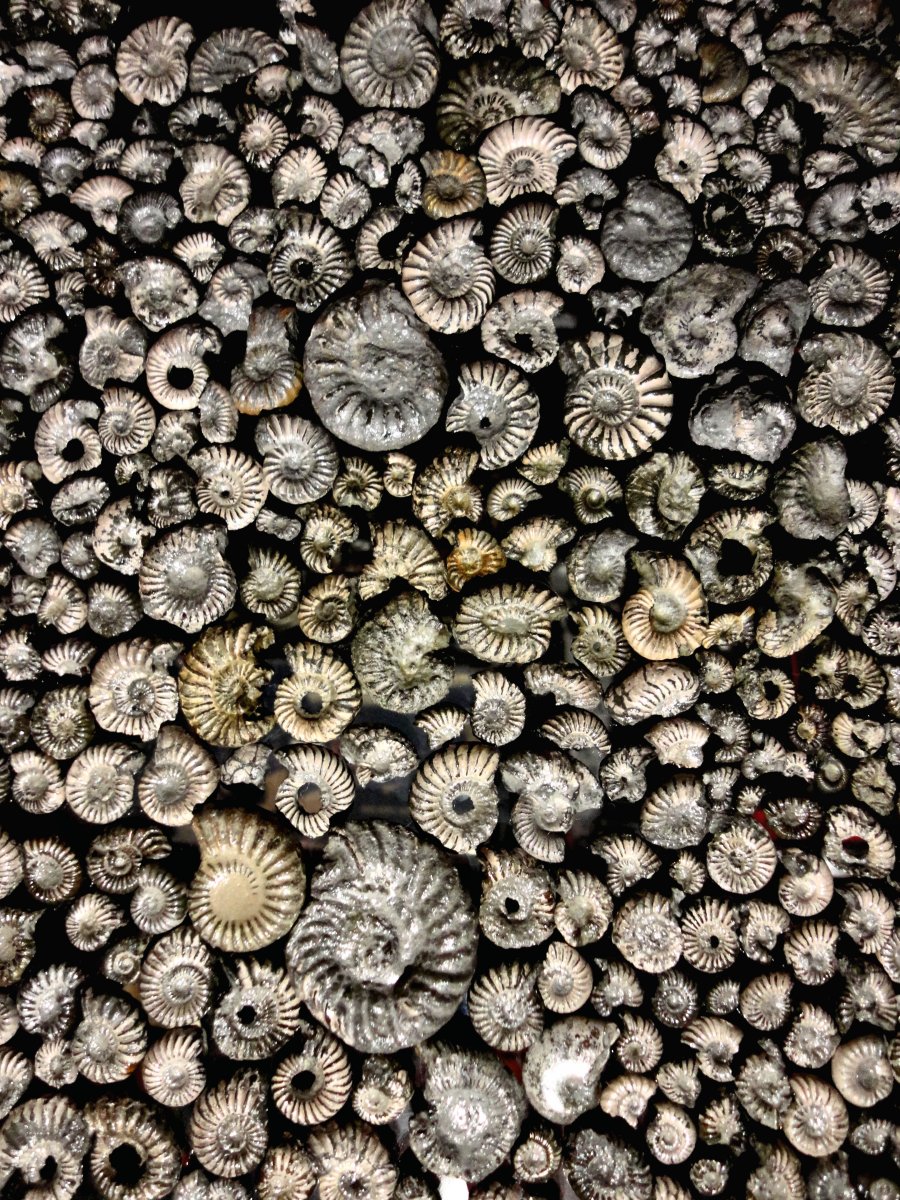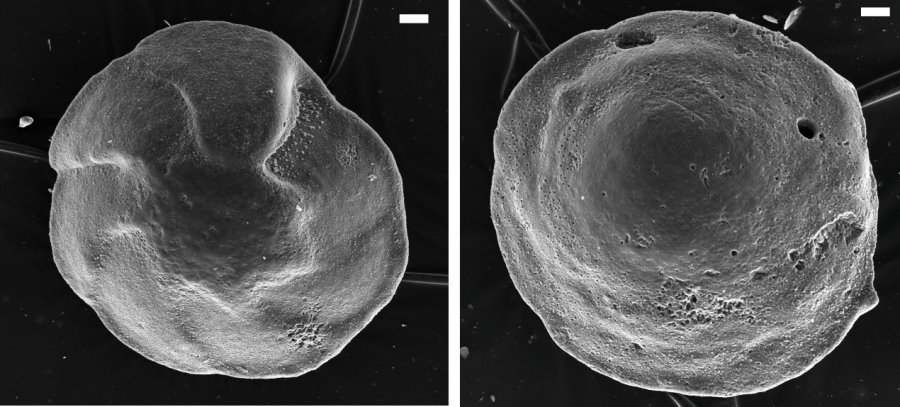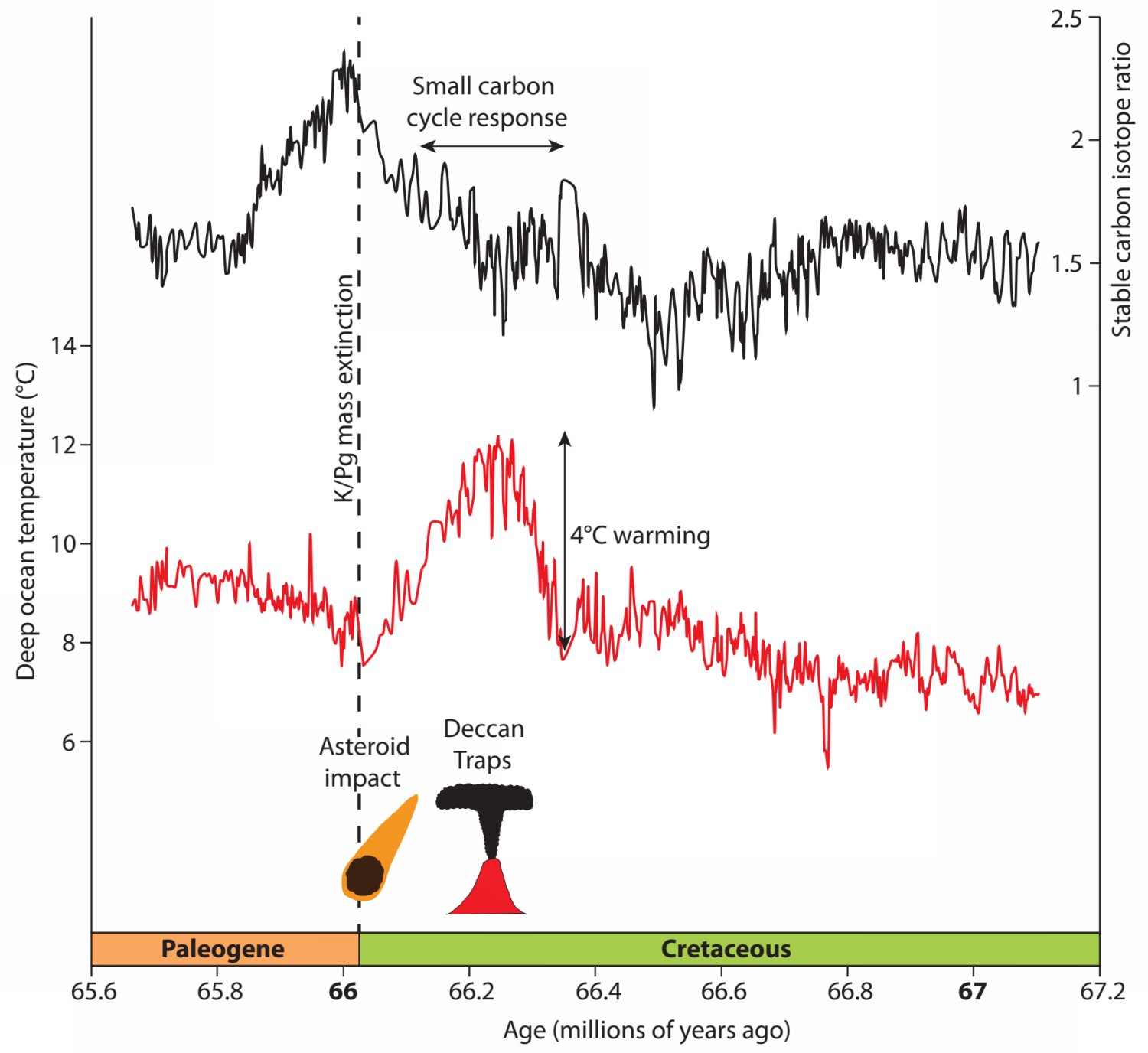
Figure 1: One of the sea-dwelling fossil groups which did
not survive beyond the K/Pg mass extinction were the ammonites.
These pyritised ammonites were collected from a single Lower
Jurassic clay horizon in the landslips below Golden Cap, near
Charmouth (Dorset). Photo from James Barnet's personal collection.
|
What caused the Cretaceous/Paleogene mass extinction?
By Dr James Barnet PhD.
Southampton Mineral & Fossil Society member
James Barnet shares some of his PhD research at the
University of Exeter that can help to shed some new light
on the Cretaceous/Paleogene mass extinction.
His research was focused on constructing
a high-resolution record of changes in deep ocean
temperature and the carbon cycle from 67 to 60 million
years ago, using samples from a sediment core drilled
in the South Atlantic Ocean at 4.7 km water depth.
This work was originally published in the magazine Geology Today,
Volume 35, Issue 2, March/April 2019. Wiley Online Library
|

Figure 2: Palaeogeographic reconstruction of the
Earth around the time of the K/Pg mass extinction, illustrating
the locations of Deccan Traps volcanism in India, asteroid
impact in Mexico, and the core site (Site 1262) sampled
during my project. Reconstruction created using the Ocean
Drilling Stratigraphic Network (ODSN) Paleomap Project.
Larger image.
|
The Cretaceous/Paleogene (K/Pg) boundary mass
extinction, which occurred 66 million years ago, is
the most recent and arguably the most famous of
the big five mass extinctions which have taken place
through Earth's history. Scientists estimate that
over 75% of animal and plant species became extinct
at this time, including the dinosaurs on land and the
ammonites in the seas. Yet despite a vast amount of
research focused on this time interval, the primary
cause of the mass extinction is still debated by scientists.
A couple of major geological events occurred around the
time of the K/Pg mass extinction, including the impact
of an asteroid (a huge lump of rock from Outer Space)
on the Yucatán Peninsula (Mexico) and major volcanic
eruptions within the so-called "Deccan Traps"
in India. These events were superimposed on a longer term trend
of cooling climate and falling sea level following the very
warm "greenhouse" climate characterising much of the
preceding Cretaceous Period. But which was the primary
cause, or did an unfortunate coincidence of geological
events trigger the mass extinction?
|

Figure 3: Scanning Electron Microscope (SEM)
images of the calcite shells of Nuttallides truempyi, used
to generate my deep ocean temperature and carbon cycle
records. The white scale bar represents 0.02 mm - these
microfossils are very small!
Larger image.
|
My PhD research at the University of Exeter can help to shed
some new light on this debate. The bulk of my research was
focused on constructing a high-resolution record of changes in
deep ocean temperature and the carbon cycle from 67 to 60
million years ago, using samples from a sediment core drilled
in the South Atlantic Ocean at 4.7 km water depth. I analysed
the stable oxygen and carbon isotope ratios recorded in the
tiny sand-sized calcite shells of an extinct species of plankton
called Nuttallides truempyi, and calculated temperatures
from the oxygen isotope data using a published temperature
calibration equation. Coupled with a high-resolution age model,
my climate and carbon cycle records can be used to disentangle
the climatic effects of Deccan Traps volcanism from asteroid impact,
and therefore better define the sequence of events which occurred
in the build up to the mass extinction.
|

Figure 4: Location and size of the crater formed by
the asteroid impact at the K/Pg boundary. The Chicxulub Crater,
named because the centre of the crater is located near the town
of Chicxulub (indicated by a red dot) on the Yucatán Peninsula, is
estimated to be 200 km (124 miles) wide based on geophysical studies.
The crater was formed by the impact of a type of rocky asteroid rich
in carbon, called a "carbonaceous chondrite", with a diameter of
approximately 10 km (6 miles).
Larger image.
|
My climate record provides evidence for a significant warming of 4 °C in
the deep South Atlantic around 300,000 years before the K/Pg boundary,
followed by a cooling to pre-event temperatures prior to the boundary.
This significant temperature rise is accompanied by a fairly small response
within the carbon isotope record, suggesting that the release of carbon
dioxide from volcanic emissions, which has a carbon isotope composition
closer to typical atmospheric composition than other greenhouse gases,
was the primary trigger for this warming event. The timing of the warming
event in my record also correlates with recent dating of Deccan Traps
volcanic rocks (basalt) in India, confirming that Deccan Traps volcanism
initiated the warming.
|

Figure 5: Location and size of exposed outcrops of
Deccan Traps volcanic rocks (basalt) in India. An unknown volume
of volcanic rocks was also erupted offshore. The immense volume of
basalt, over 600 km (373 miles) in diameter, now forms an impressive
mountainous region covering a significant portion of western India.
Larger image.
|
Although Deccan Traps volcanism is known to have continued
across the K/Pg boundary up until around 65.5 million years ago,
it appears that the major climatic effects of Deccan Traps volcanism
precede the K/Pg extinction by a few hundred thousand years.
Meanwhile, reliable dating of the impact layers rich in the extraterrestrial
element iridium, have revealed that the asteroid impact coincided
exactly with the boundary. My research therefore strengthens the argument
that asteroid impact was the primary driver of the K/Pg mass extinction,
due to the rate, magnitude, and type of environmental change.
Whilst my temperature record shows that warming associated with
Deccan Traps volcanism occurred over 80,000 years, environmental change
during the asteroid impact was orders of magnitude faster and more severe.
Such changes include an extended period of darkness, major global cooling
(of up to 10 °C), and acid rain, during the "impact winter"
over the first few years to decades after impact. Such rapid environmental
changes do not allow time for animals or plants to migrate or adapt to the
changing environment. Furthermore, prolonged darkness would have created
a significant reduction in photosynthetic activity (i.e., plant and phytoplankton
growth), and hence a collapse of the food chain both on land and in the oceans.
Although asteroid impact appears to have represented the final blow to plant
and animal communities 66 million years ago, there is evidence for a decline
in species abundance during the final one to two million years of the Cretaceous.
Deccan Traps volcanism, along with long-term changes in climate and sea level,
may therefore have played a contributory rather than a causal role in destabilising
plant and animal communities prior to asteroid impact at the K/Pg boundary.
|

Figure 6: Stable carbon isotope and temperature
records generated during my PhD, clearly illustrating that global
warming associated with Deccan Traps volcanism occurred before
the K/Pg mass extinction. The extreme climatic effects of the
impact winter following asteroid impact are not observed in my
records due to the extremely short timescale (years to decades),
which would not have had a significant long-term impact on the
temperature of the deep ocean.
Larger image.
Further reading
Barnet, J.S.K., Littler, K., Kroon, D., Leng, M.J., Westerhold, T., Röhl, U.,
and Zachos, J.C. 2017.
A new high-resolution chronology for the late Maastrichtian warming event:
Establishing robust temporal links with the onset of Deccan volcanism.
Geology, v. 46, p. 147-150.
Schulte, P., Alegret, L., Arenillas, I., Arz, J.A., Barton, P.J., Bown, P.R., Bralower,
T.J., Christeson, G.L., Claeys, P., Cockell, C.S., Collins, G.S., Deutsch, A., Goldin,
T.J., Goto, K., et al. 2010. The Chicxulub Asteroid
Impact and Mass Extinction at the Cretaceous-Paleogene Boundary.
Science, v. 327, p. 1214-1218.
Renne, P.R., Sprain, C.J., Richards, M.A., Self, S., Vanderkluysen, L., and Pande, K. 2015. State shift in Deccan volcanism at the
Cretaceous-Paleogene boundary, possibly induced by impact. Science, v. 350, p. 76-78.
|
|
James Barnet is a member of Southampton Mineral &
Fossil Society. He can be
contacted through the Contact menu option above.
© Southampton Mineral & Fossil Society and the original author.





